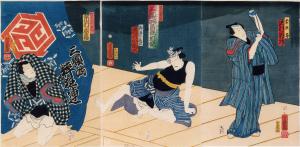A New Work from the Sandai-banashi Impromptu Storytelling Stage (Sandai-banashi Kōza-no Shinsaku Number 2)
Illustrated by Ochiai Yoshiiku 1863 (Bunkyū 3) New Acquisitions WA-BE 39
This colored woodblock print shows the program of "Kamiyui Tōji" (Hairdresser Tōji), originally a sandai-banashi Rakugo that was adapted into a Kabuki play.
The famous Kabuki playwright Kawatake Shinshichi II (later known by the name Mokuami), was also a prominent member of the Suikyō-ren Rakugo group. He once performed a sandai-banashi impromptu Rakugo narrative based on the following three themes: "Kokusenya" (the name of a mixed Chinese/Japanese Ming loyalist of the early 17th Century, also known as Zheng Chenggong or Koxinga), "suckled by others," and "hair dressing." Shinshichi proceeded to adapt the story for Kabuki at the request of the actor Ichikawa Kodanji IV, and it was first performed at Edo Ichimura-za Theater in February 1863 (Bunkyū 3). Kodanji played the role of Kamiyui Wakokubashi-no Tōji (Tōji the hairdresser of Wakokubashi), while Hiranoya Kōjirō was played by Sawamura Tosshō II, and Kinchakukiri Takemon-no Tora (Tora the pickpocket of Takemon) was played by Ichimura Kakitsu II.
At this time, the Suikyō-ren and Kyōshō-ren groups presented Shinshichi with a stage curtain. An aficionado would sometimes present an actor with a stage curtain, but its presentation to a Kabuki playwright was an exceptional honor, and represents a noteworthy event in the history of Japanese theater.
Sandai-banashi stories supplied material for not only for traditional Rakugo, but also Kabuki, stage plays, and other art forms. Their influence extended to Japanese literature of the late Edo Period and early Meiji Era.


